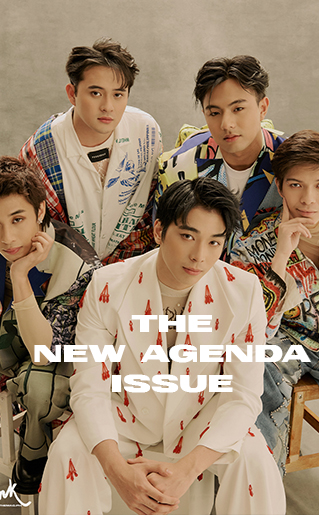A larger-than-life projection that read “Mula Sa Buwan” hovered at the façade of the newly inaugurated Samsung Performing Arts Theater in Circuit Makati—like a north star that invited throngs of theater goers on opening night of the returning original Filipino musical.
Droves of faithfuls and first-timers swarmed the venue and fell in line with vaccination cards and alcohol spray bottles in tow as the buzzing of friends, colleagues, and fellow enthusiasts gleefully anticipating the start of the show or just reveling at the idea of coming together after years of distance for a new shared experience in the theater slowly enveloped the whole of the building.
It was a familiar but startlingly different sight, but the pervading atmosphere was beautiful—hair-raising even. It felt like a homecoming of sorts, something that the people behind “Mula Sa Buwan” aptly described the return of the beloved production in their countless press runs.
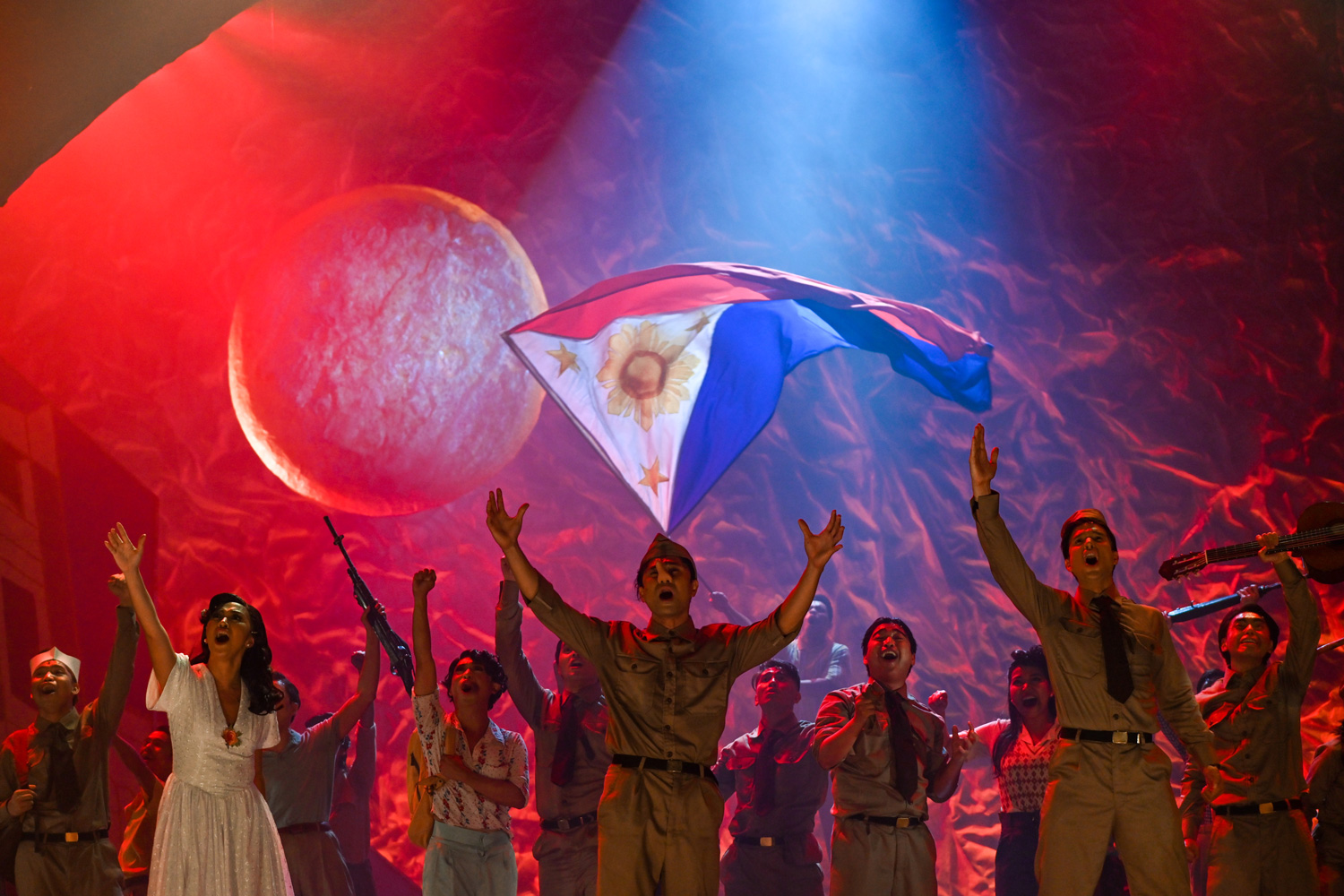
Photographed by Kyle Venturillo
To the uninitiated, “Mula Sa Buwan” is based on Edmond Rostand’s classic French play “Cyrano de Bergerac” through Francisco “Soc” Rodrigo’s canonical Filipino translation, where the main, familiar storyline was retained, with elements that were reimagined to resonate with Filipino sensibilities, whereas sarsuwela is commonplace, a Paris bakeshop from the source material becomes a cabaret reigned by a seemingly “omnipresent” queen of the misfits, and soldiers are replaced with young cadets in the face of a dark, looming war in the period of the Japanese occupation in the Philippines.
The production writes, “Now set in 1940s Manila, the musical features wide-eyed dreamers, fools, and misfits where harana, kundiman, together with passion and genuine friendships, abound! Through wit, stories, and music, they dream and fight for their place in an ever-changing city. However, when war strikes, love, ideals, and truth are all tested–the young are now suddenly forced to ‘grow up’.”
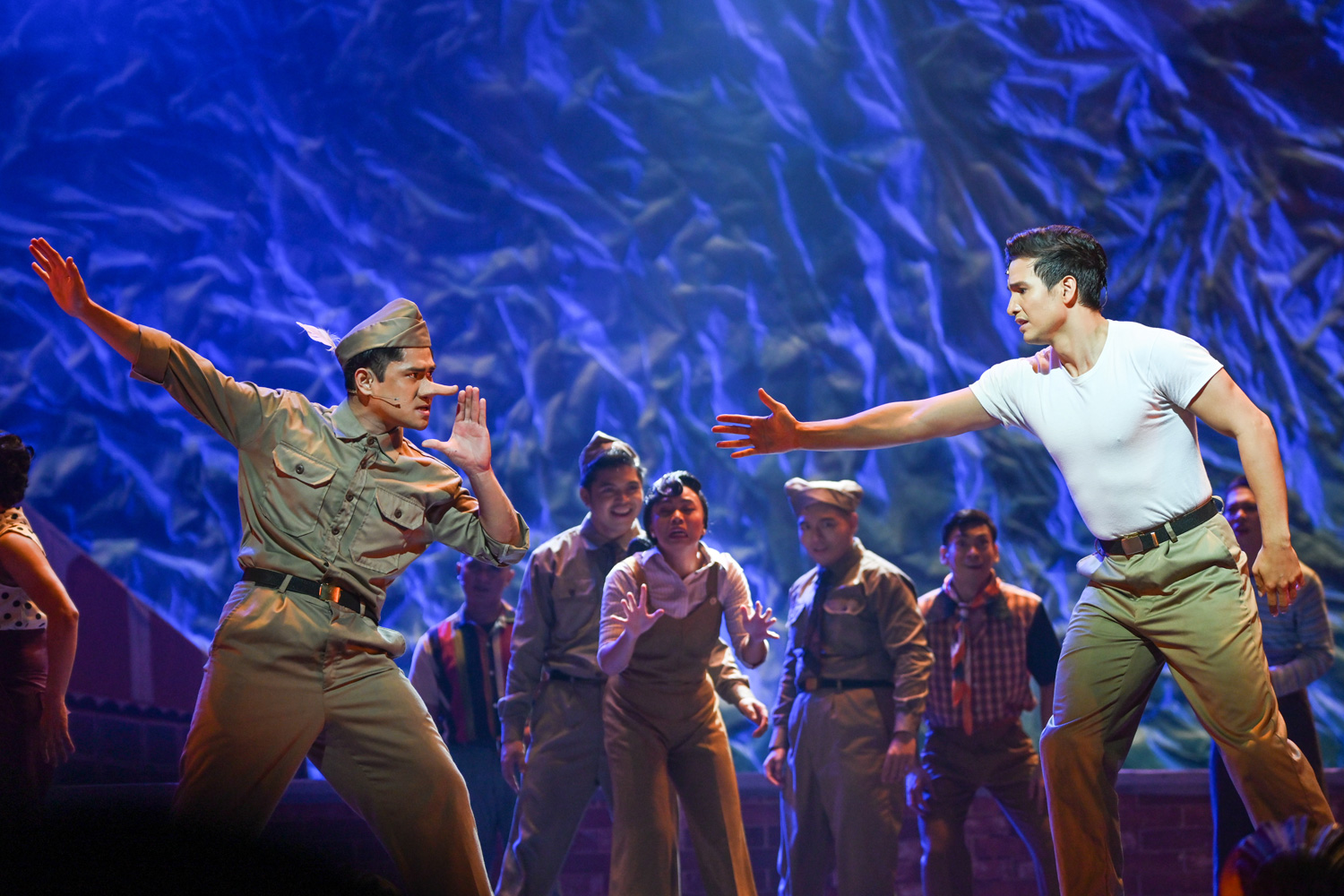
Photographed by Kyle Venturillo
Cyrano (Myke Salomon), cartoonishly-huge nose and all, is secretly in love with his childhood friend Roxane (Gab Pangilinan). The irony is, Cyrano, while decorated with a reputation of displaying bravery, smarts, and a colorful way with words, cannot profess his feelings with a fear of being rejected because of the way he looks.
In comes, the extremely handsome, but “simple-minded” Christian (Markki Stroem), who catches the gaze of Roxane, and the two almost instantaneously falls in love. Roxane then seeks the help of Cyrano to connect her with the latter. Agreeing on this, whatever deep admiration Cyrano has for his friend, he pours in beautiful words and poetry under the guise of Christian’s letters in an age-old scheme we are all familiar with.
On a cursory search, the story of Cyrano de Bergerac is one that has been translated in almost every decade—from earlier direct adaptations in films, and down to loose, derivative interpretations on Netflix and even Korean dramas—navigating the universality of its themes from saccharine demonstrations of unrequited love to darker turns of what we have come to identify in recent years as “catfishing”.
The beauty of this reimagined world of Cyrano in “Mula sa Buwan” is it has the luxury of standing on its familiar storyline alone and pulls the audiences in even with very little to no recollection of scholarly readings or even recent direct adaptations of its original text. And even if you do remember scenes from its film adaptations at the least, it holds itself truthful to what it wants to say.
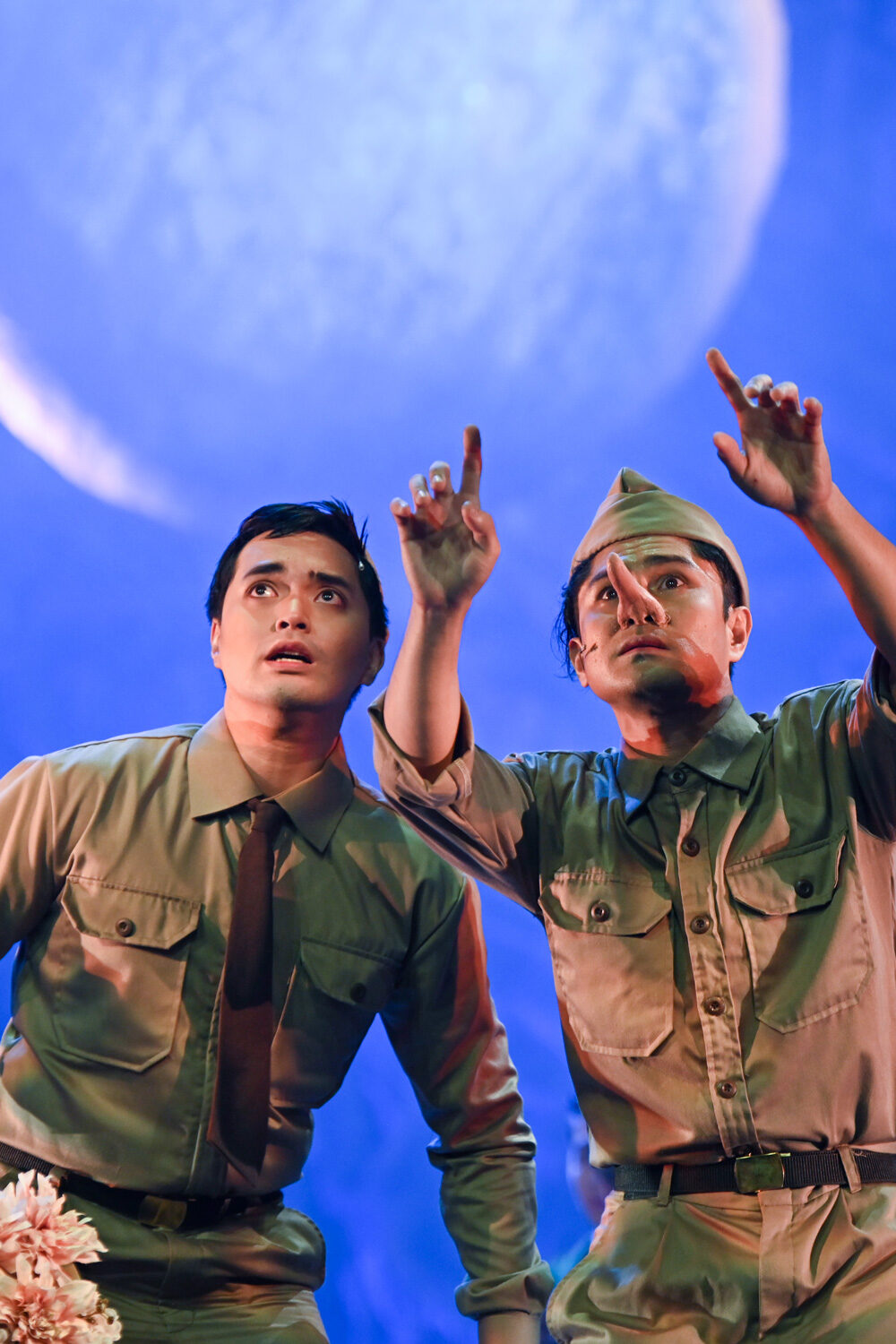
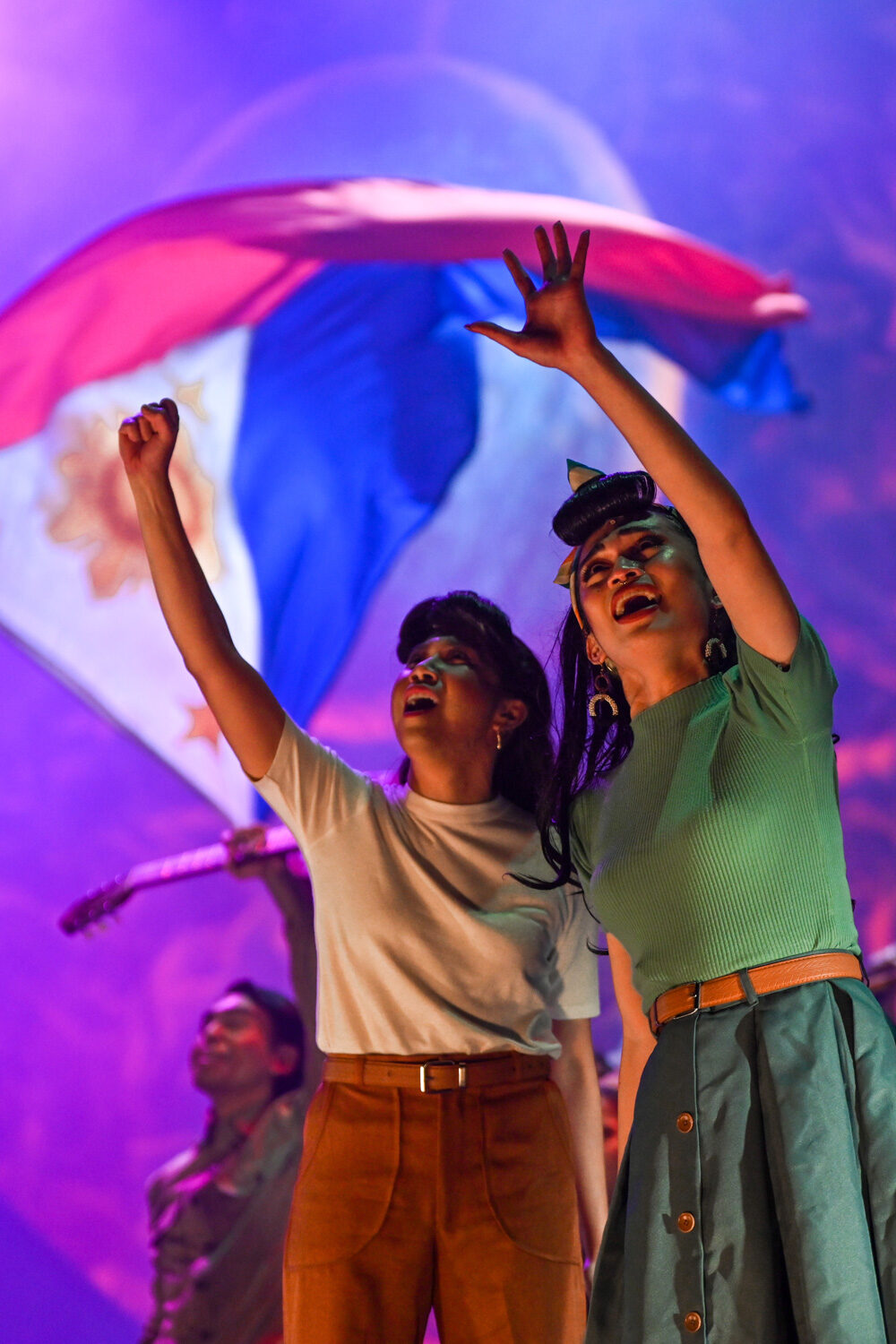
Photographed by Kyle Venturillo
Above all else, its strength lies in allowing us to suspend disbelief. After all, you are watching a main character with a comically large nose, prosthetic one at that, and a woman who doesn’t recognize her friend’s voice in the dark. If any production does not capture your attention and holds you down to watch a three-hour journey unfold, it fails. But the musical, in all its intent and storytelling, soars.
“Mula sa Buwan” may have tailed a handful of “stubborn” productions that braved the odds of staging a show amid the continuing pandemic but it cannot be denied that the grandness of scale of the whole experience with a loved stage event as this in a new, beautifully-designed venue at that, delivered an emotional ride—especially if you are a fan of the theater, or live events for that matter, relishing on every bit of experience from traipsing down the freshly-lacquered hallways, then hearing the quiet whirring of the tall escalators leading up to the massive 1500-seater auditorium.
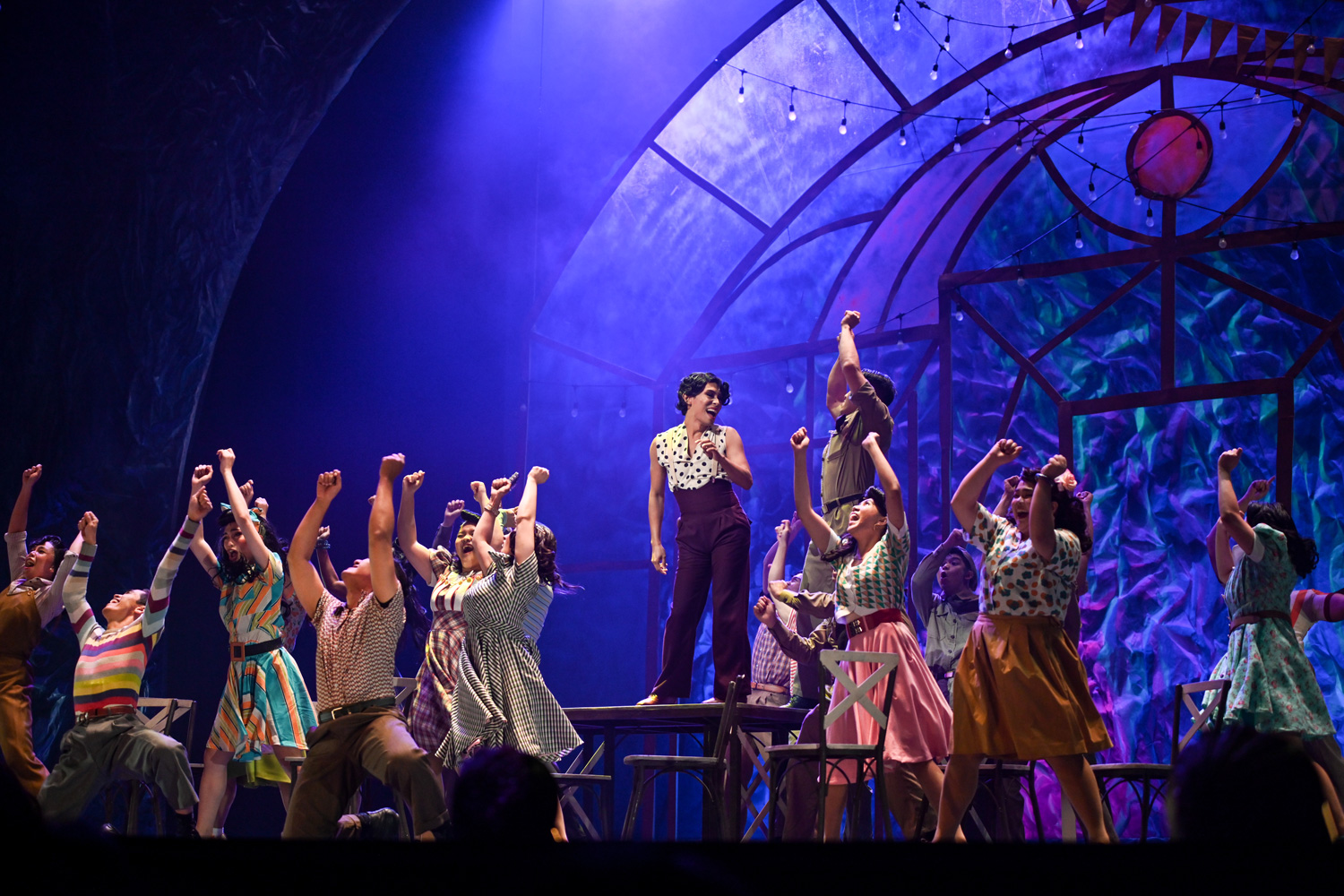
Photographed by Kyle Venturillo
All of these said, it is easy to be lost in the sentimentality of the whole idea that live theater is back and not holistically see and pore over how great or wanting a production is and assess it for what it is over what it means and what it represents. True, separating the art for its merits alone from its milieu and even its social context at a time it is being staged is hard, especially in this era when we are still trying to decloak ourselves from the veil of darkness of the past two or so years, as we go back to normalcy, or whatever we remember of it.
Such is the tricky case with Pat Valera and William Elvin Manzano delivering their hit musical today, four long years since the production last saw its curtains raised on a live stage, while almost three of those years, the world was caught in a standstill and a phalanx of supporters that flocked a live venue to get a taste of the complete theater experience, just like it did on opening night and the days that followed this success, was nowhere in sight.
There are those, for the sake of “counter-narratives,” who called and diluted praise for this restaging of “Mula sa Buwan” as “unearned, sentimental platitudes,” warning that because the production, deemed to “ride the wave” of the “cultural movements of the present times”—the COVID-19 pandemic still a threat, and the socio-political climate in disarray—its emotional pull could very well overshadow, or overcompensate for its artistic merits or lack thereof.
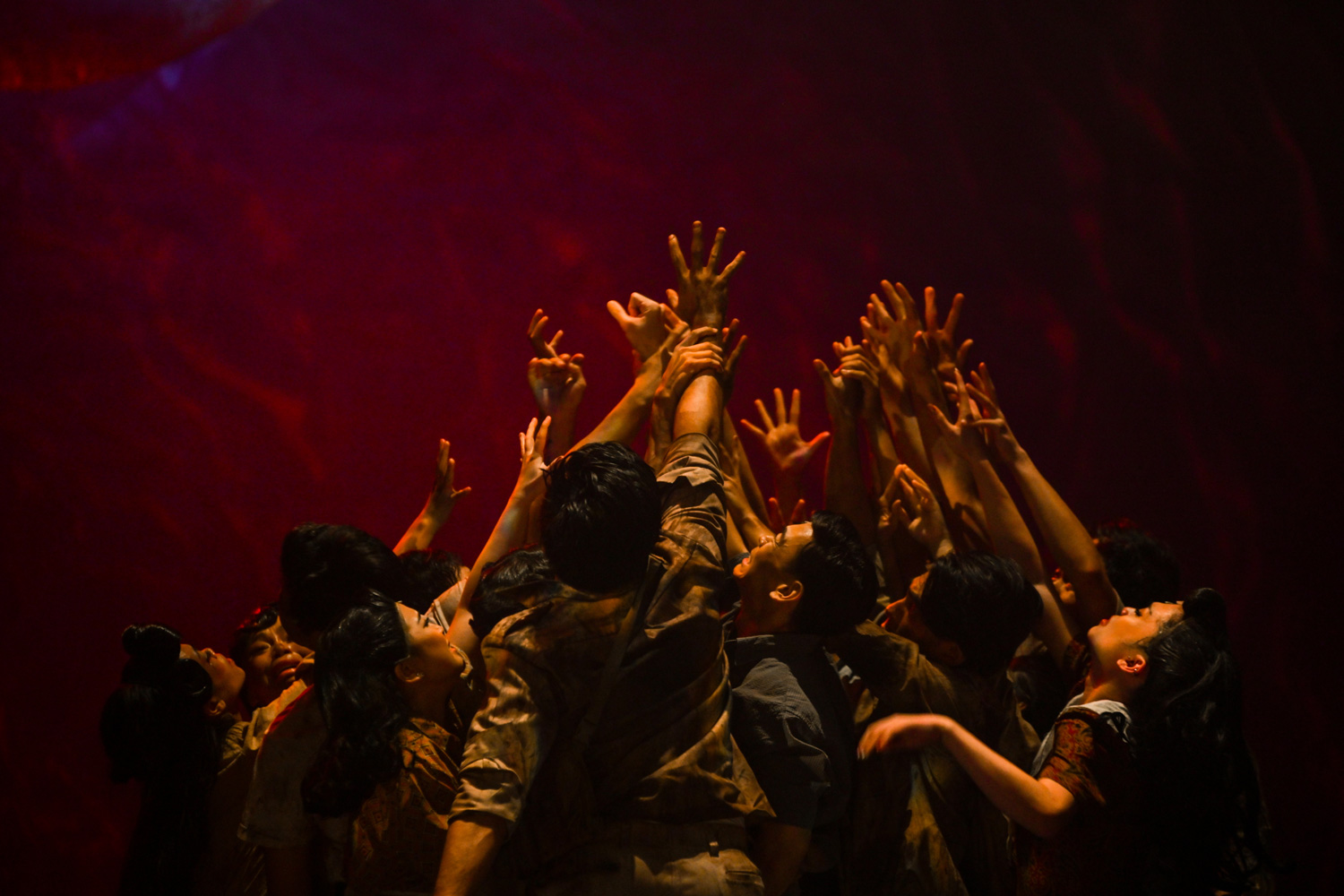
Photographed by Kyle Venturillo
While this sounds valid, one can surmise, isn’t reading through the significance of “Mula Sa Buwan” and its impact in today’s social temperament the most “human” thing to do? And celebrating returning to things that, even at the slightest sense, resembled normalcy, in and of itself, a shared experience worth noting instead of outlining a checklist of trivial flaws that would surprisingly be grounds enough to call it a failure “at every turn”?
To dismiss the idea of looking at “Mula Sa Buwan” or any live theater production that came out of our collective two-year hiatus, for its totality more than as an art form but a vocation amid a time of uncertainty is a disservice to the boldness and trust not just of every single actor and crew behind any production, but every single theater goer who is brave enough to wade through city traffic to get their taste of live theater again.
If anything, Valera and Manzano, bringing this latest iteration today to mirror and echo the present times, doesn’t seem to simply ride on what’s current. It gives them a stronger sense of purpose and a deeper meaning to its staging. And that’s why it worked. That’s why people fell in line and trusted that they will come home safe even if the probability of infection still lingers. That amounts for something that goes beyond looking at it as a theatrical production to be dissected whether it is good or not.

Myke Salomon. Photographed by Jerick Sanchez.

Pat Valera. Photographed by Jerick Sanchez.
In an interview with Rank Magazine, Salomon, who plays Cyrano and doubles as musical director for this fresh iteration, says, “A theater production o ang isang dula ay isang celebration of human existence. For me, it’s the highest form of communication, ito ‘yung pinaka-mataas na antas ng pagchi-chikahan.”
Valera could not have put it even better, “There’s a wish with every playwright that what we write urgent now or what I wrote then, wouldn’t be as urgent in the future. That’s why it’s live theater. We want to discuss what is urgent today. Yet, somehow, because there’s ‘forget’, history repeats itself, and people do not know what history is, or love doesn’t win after all—or hasn’t won yet, that the play becomes relevant again.”
That said, “Mula sa Buwan” and this year’s fresh, limited-run, is a fitting prelude to the return of live theater, with thespians and first-timers trooping and congregating at the venue to experience theater once more after years of isolation and distance. It brings the stories of the past and connects these with the humans of today, allowing us to be transported into a state of reverie and reflection.
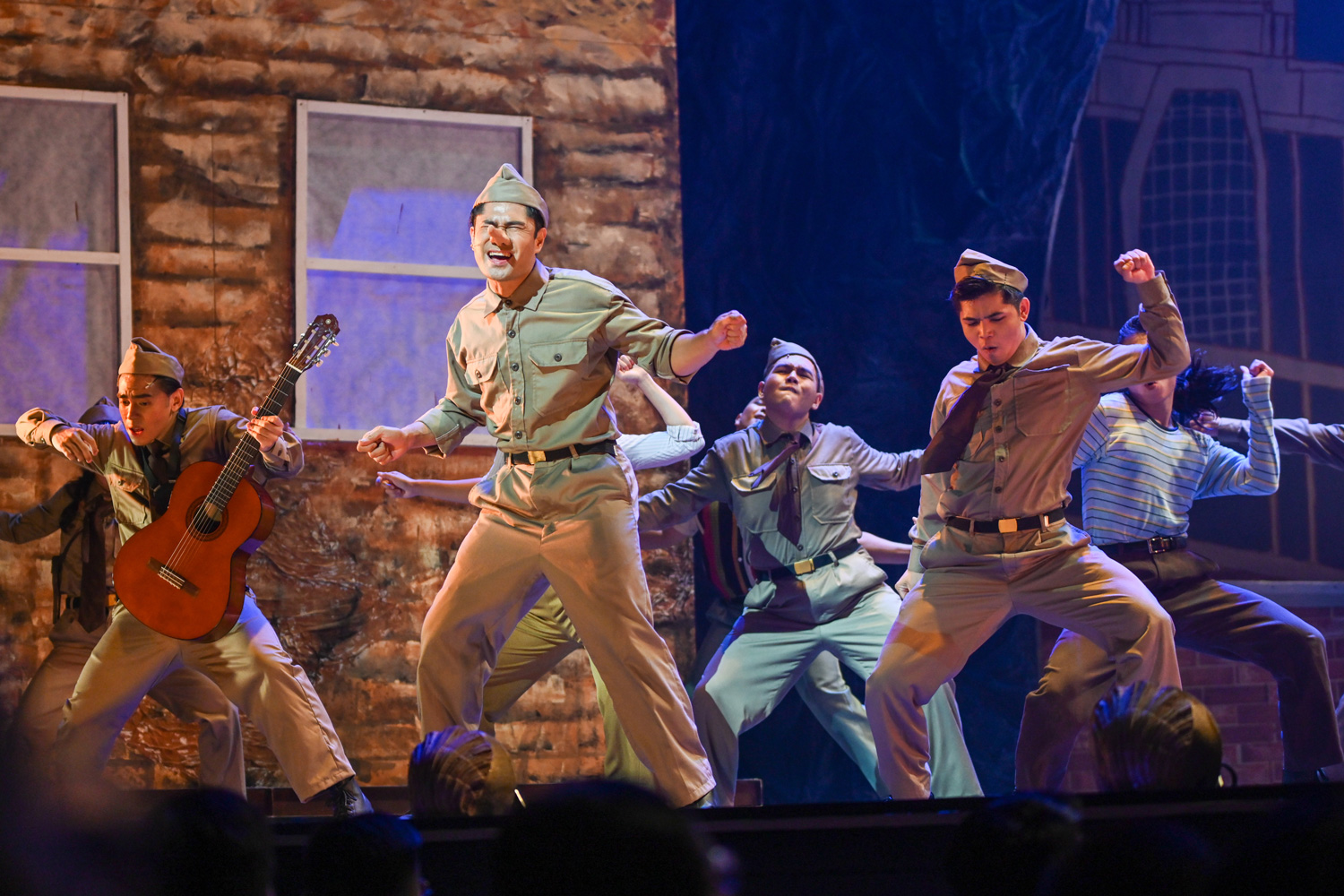
Photographed by Kyle Venturillo
As “sinfully sentimental” as these songs of praise sound, it is not without its fumbles though. On a narrative sense, one can hope that with the creative freedom the team had the liberty to employ in bringing this interpretation to the modern times, as impressive and tight-knit as the ensemble is, it would have given more clarity and strength if the amorphous band of “misfits” and “societal rejects” have been fleshed out more instead of just existing in the background.
Being more forthright about what, in essence, turned them to be these socially shunned “misfits” in the first place would have given them more dimension than say, planting fleeting visual suggestions of men liking men onstage or just the overarching idea of young people who express frustrations among one another in song and dance, without seeing them out of their “safe space” with one another and in the “real world”, save for one or two sequences, for the audience to fully connect on why they call each other and the moon their home, and this society or world not theirs.
The same goes with the character of Rosanna (Phi Palmos), whose quietly placed angle on unrequited love with Cyrano could have had more depth than just brief comedic quips for a few laughs. A recognition or acknowledgment written in on the plot instead of just a momentary, indirect demonstration of affection in the end would have made more impact to the whole psychology of the show’s ethos of abolishing labels and calling for representation and inclusivity.
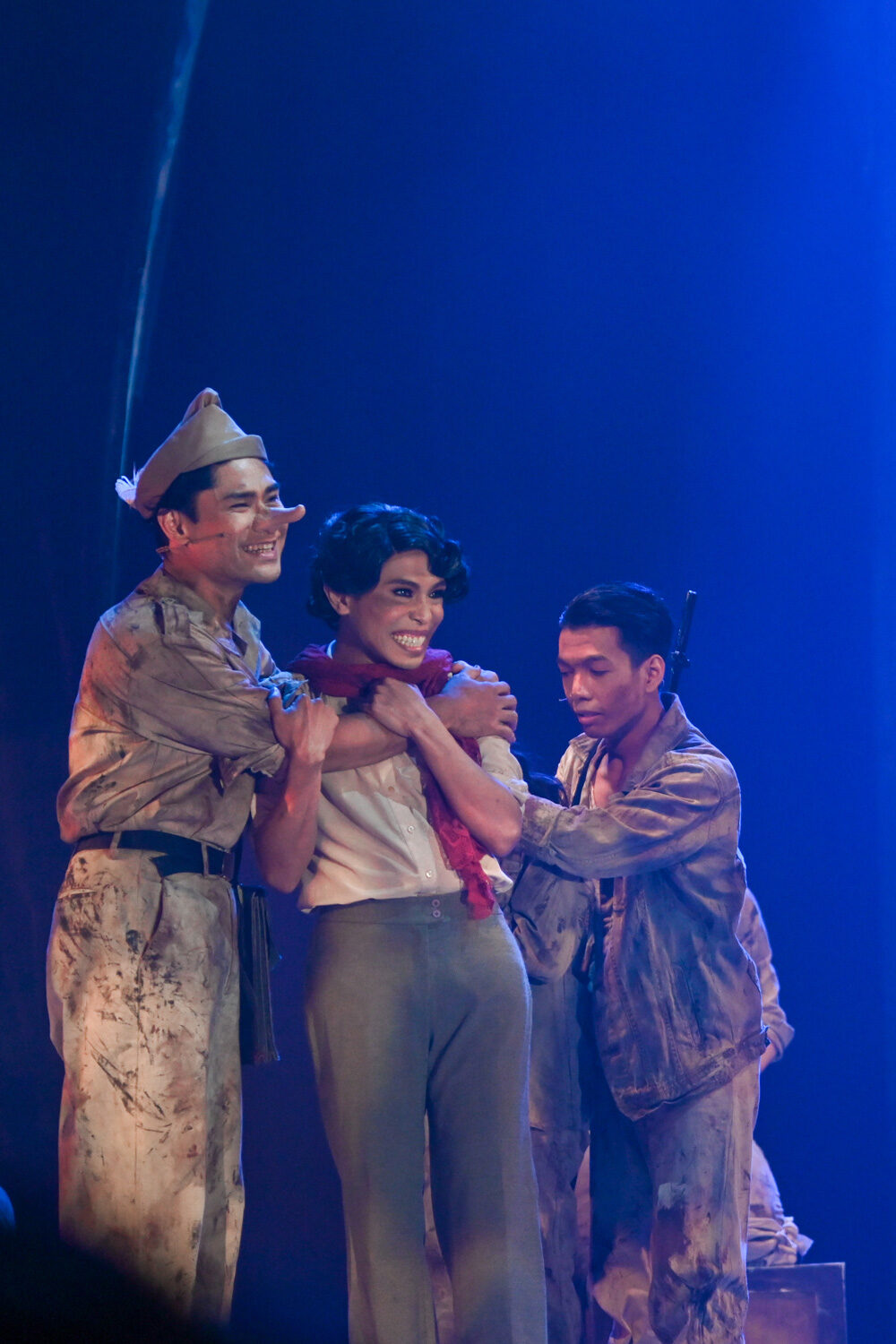
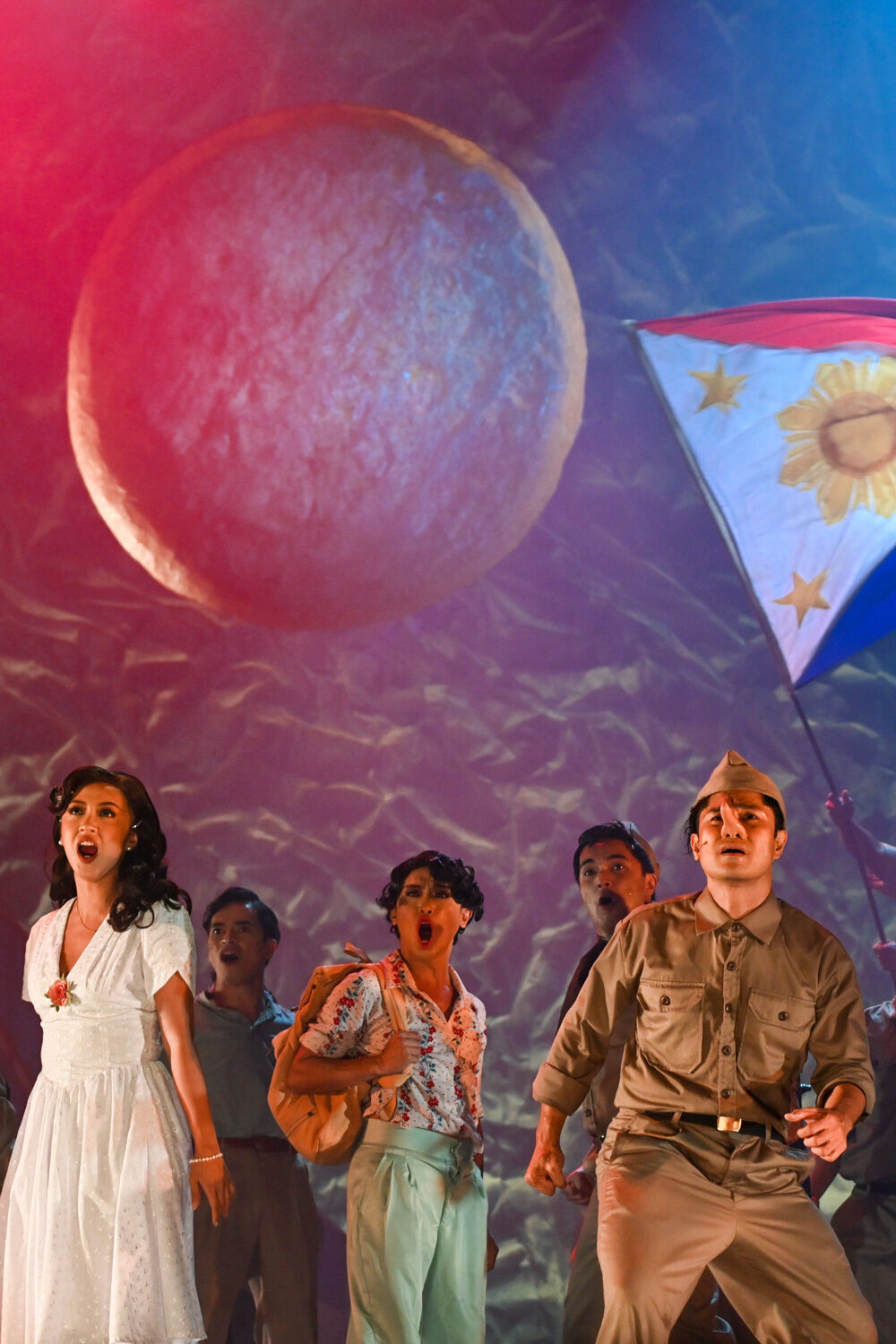
Photographed by Kyle Venturillo
Similarly, Stroem’s character of Christian, while effective in providing comic relief in areas it needed to, has very little to no room to work with aside from taking on the token pretty boy but admittedly “stupid” trope, and much of his humanity has been left untapped and underdeveloped, except in the end, in one of the more cathartic moments of the show.
But then, of course, these to this writer, may just be narrative inadequacies that are natural to the limitations already present in working with adapted text and the very thin line that is tricky to navigate with when faced with the dilemma of either staying faithful to the source material or exercising enough freedom, which naturally runs the risk of deviating too much from the original text.
On its artistic technicalities, watching on opening night, it was apparent that there’s much room for refinement, from uneven sound distribution and occasionally distracting mic glitches, as well as its set pieces, albeit vibrant and somewhat larger-than-life, that, in parts, looked unsteady and crafty than matching the grandness in scale of the enormous stage.
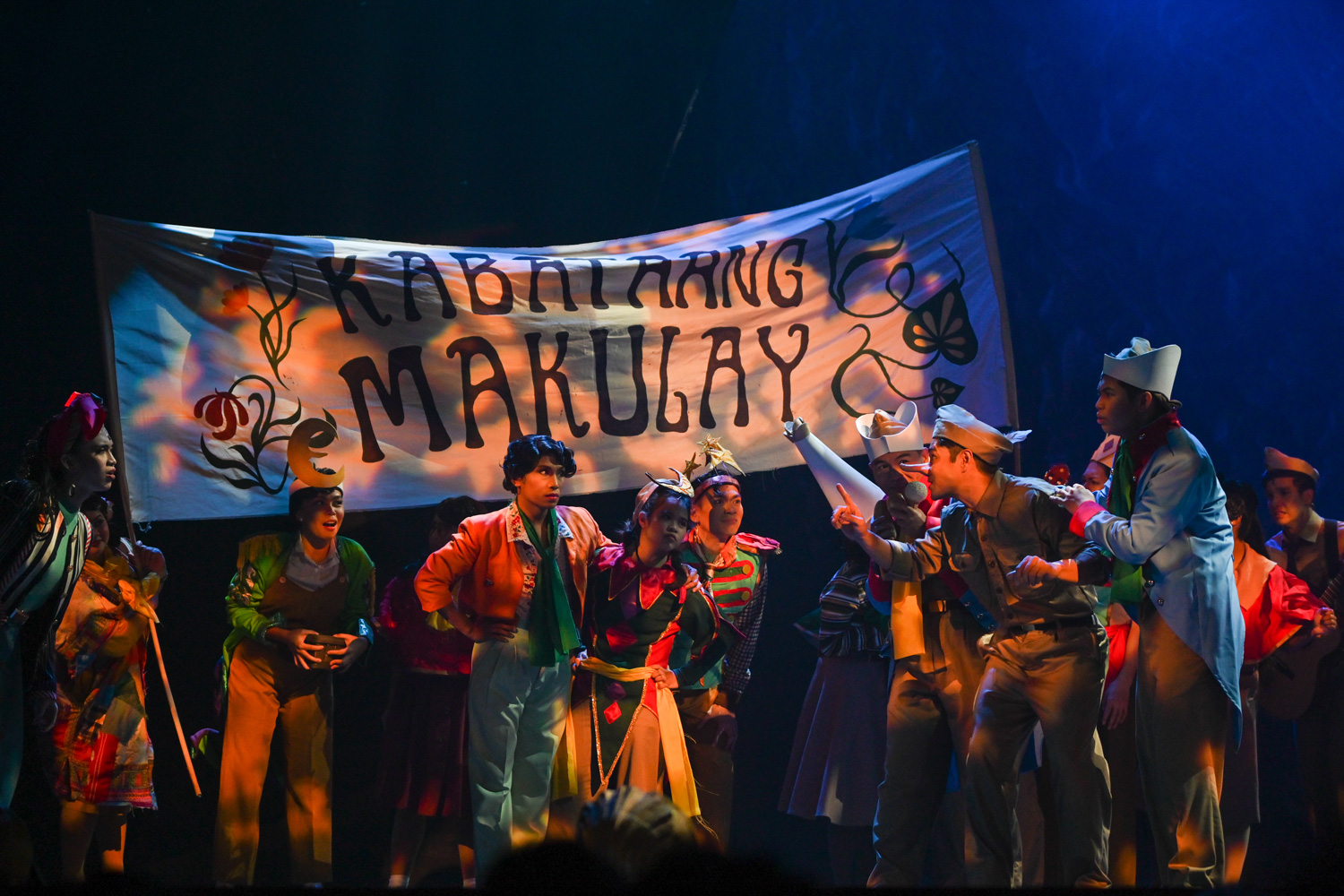
Photographed by Kyle Venturillo
All of these “lapses”, if we may call them that, are all allayed by the power of its simple but profound storytelling with a visual and sonic mastery that draws its audiences in the minute the theater lights dim and the first bang of its hypnotic drums cradles the whole of the auditorium in a familiar, but otherworldly dimension, especially with its impeccable use of language and delivering it to be palatable to its diverse generations of audiences.
With Rodrigo’s original translation and the book and lyrics of Valera, complemented by Manzano’s music and Salomon’s musical direction, the musical gives due highlight to the beauty of the Filipino language.
In one of its more popular romantic hymns, “Ikaw” sung by Cyrano, the lyrics read:
Maiinggit ang bukang liwayway
Ang ganda niya’y nawalan ng saysay
Sa kulay mong tinataglay
Sa mundo’y binibigay
Not just on its noteworthy slate of original songs, in one of the defining moments in the play with the three leads, Cyrano beautifully uttered,
Hiniram ko ang dilim ng gabi,
Tila kumot sa aki’y nagkukubli
Nakikita mo lamang ang anino kong tangan
At batid ko ang liwanag mong kagandahan
While leading to one of the show’s most soulful anthems, the titular hymn, “Mula Sa Buwan”, Cyrano’s declaration, fists up and eyes beaming with questions and hope, sounded like this:
Alam kong nais mo’ng umalis
Sa mundo’ng pag-ibig ay di makamtan,
Dahil may itinakda nang nararapat para sa dapat
Dahil walang puwang ang panaginip na kay tapang
Kung sa’n di makalutang dahil sa hugot nitong mundo
Lisanin na natin ang lugar na ito
Paalam!
Paalam, mundo’ng hindi naming tahanan.
“Mula Sa Buwan” fashions a masterful marriage of language and music used to elevate the way it tells its story. And even with the risks of alienating viewers with the very esoteric nature of the setting’s deep vernacular, especially in the longer monologues, the dynamism of the elements, from the original score in its quieter parts, the lights used by Meliton Roxas, the costumes of Bonsai Cielo, and the sharpness and life of JM Cabling’s choreography, all of these are perfectly conveyed and tied tightly together by Valera’s precise and smart direction—melding all elements incredibly well in one organic, soulful masterpiece.
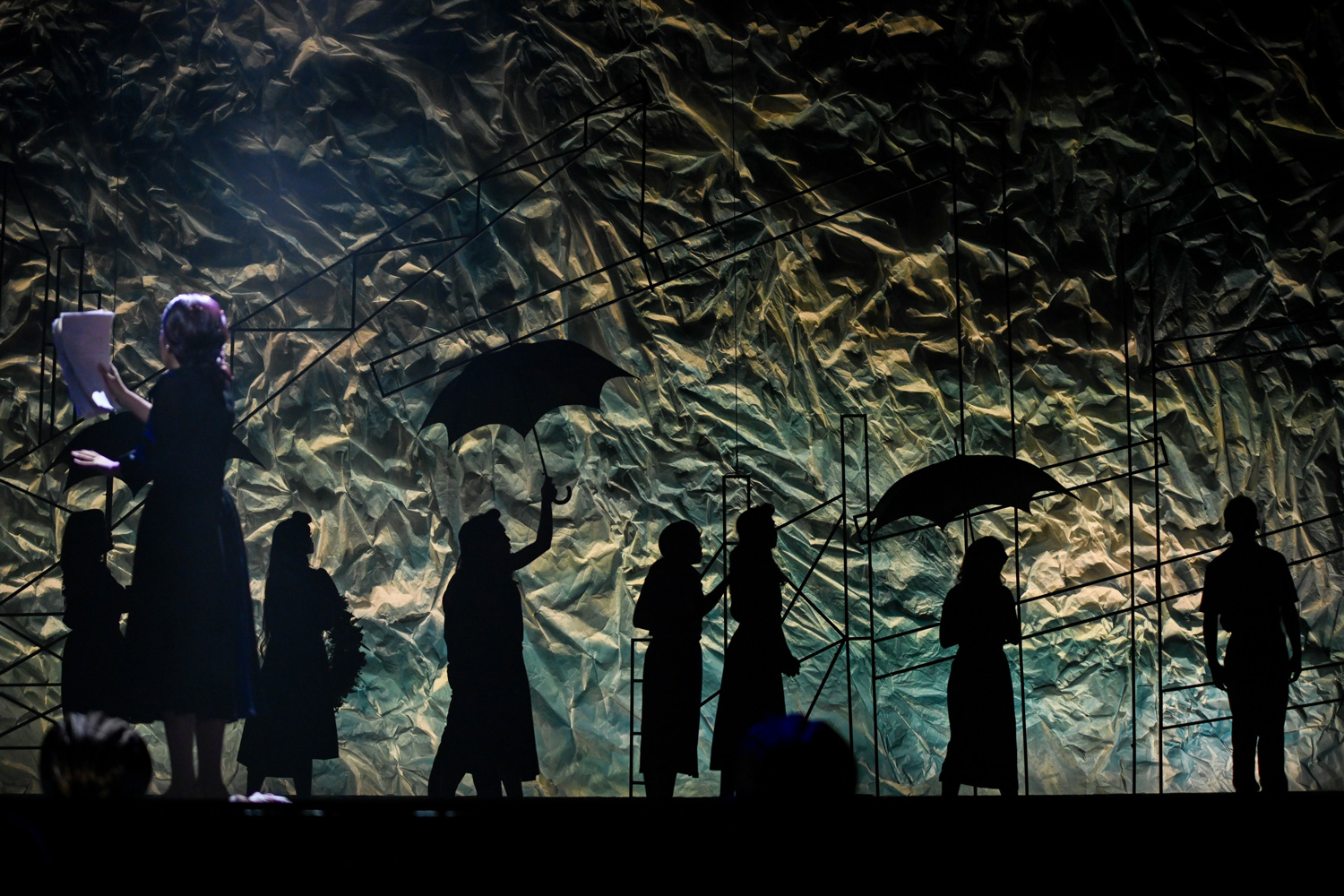
Photographed by Kyle Venturillo
Valera, of course, has the luxury of playing around and weaving the piece with the sheer firepower of its cast. The cadets under Cyrano were played by Stephen Viñas, Abe Autea, Jep Go, Rapah Manalo, and Ericka Peralejo while its ensemble includes Shaira Opsimar, Miah Canton, Khalil Tambio, Francis Gatmaytan, Mitzie Lao, Deborah Lemuel, Mark Anthony Grantos, Eizel Marcelo, Kinnara Mayari, Ace Polias, Liway Perez, Lance Reblando, Mikaela Regis, Chesko Rodriguez, and Keith Sumbi.
MC Dela Cruz brings the journey of Maximo’s reversal of fortune and even character with such delight. Jon Abella as Tato and Jillian Ita-as as Gabriel deliver scene-stealing comedic quips that essentially ground the show. Stroem, returning to the stage a long while after his last, gave a disarmingly charming performance and a reminder of his vocal and acting chops. Save for some vocal choices, to no fault of his own, that might have been anticlimactic in parts, it is Palmos’ quiet confidence and sense of self-assuredness that commanded that stage as Rosanna.
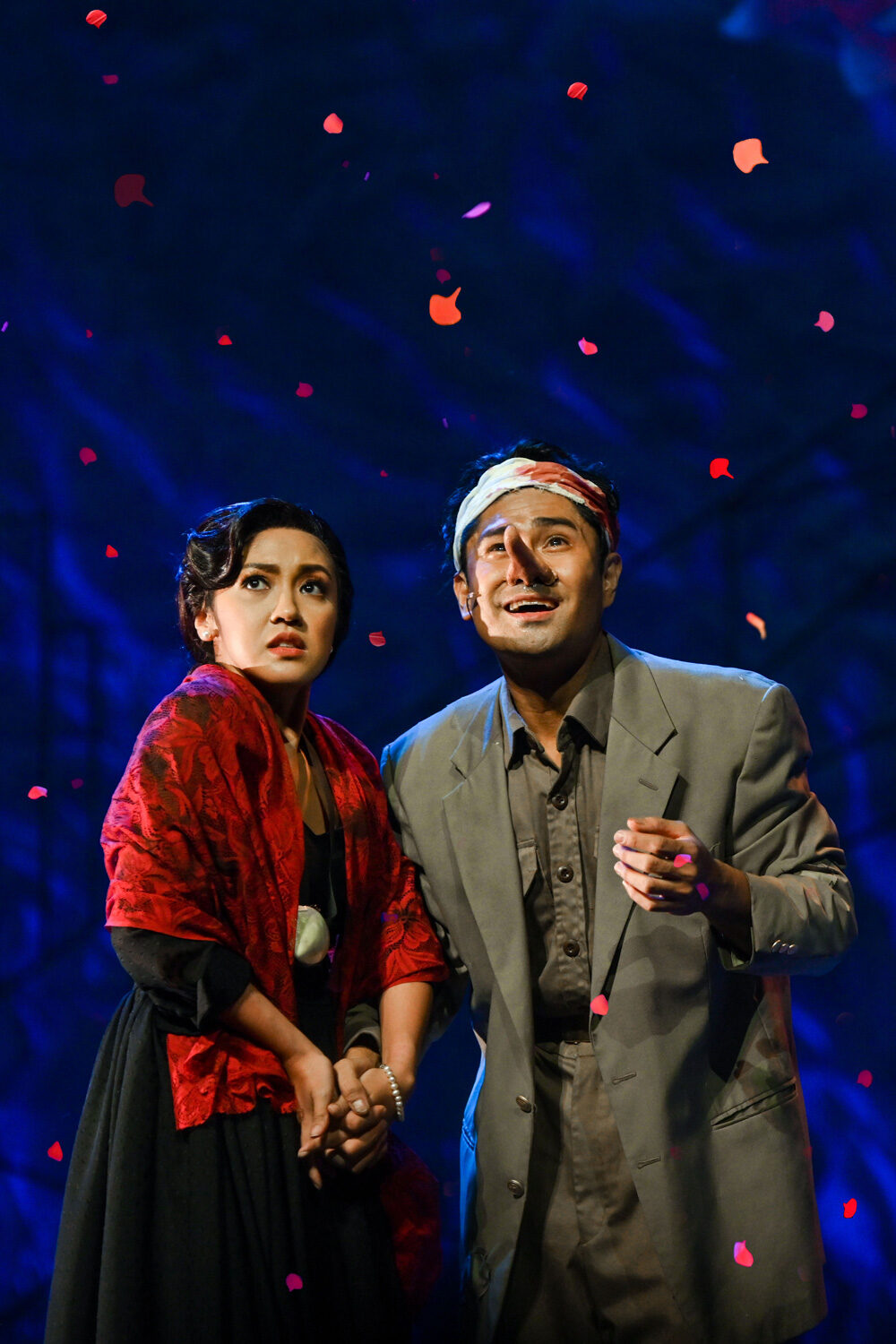
Photographed by Kyle Venturillo
Salomon’s career-defining take on the role of Cyrano with such infectious verve and passion, beefing up his already untouchable body of work both as an actor and musical director, only amplified him for the powerhouse that he is, and deservedly so. And even as he shifted from comedic to somber and dramatic in different parts of the show, his vocals have not been praised enough especially with the endurance in keeping his Cyrano-ness on a 10 almost all throughout the three-hour show.
At the core of it, it is Pangilinan’s return as Roxane that really elevates the show to what it is, demonstrating a masterclass in singing and acting effortlessly. If you think you know how Pangilinan sounds, having been the face of Philippine theater as Joy in the success of the pandemic streaming of “Ang Huling El Bimbo”, her performance in this staging, what with her pristine vocals and depth in her eyes that gives her character such gravitas, is nothing short of sublime. Her powerful and pained aria “Ang Sabi Nila” may be the obvious choice when thinking of her most memorable performance in the show, but it really is the smaller parts and vocal stylings that showcase mastery of her instrument.
For what it is and what it represents, “Mula sa Buwan”, in all its splendor and jaw-dropping glory, transcends from its very description of a “story of love and defiance”. It is not merely a story of love and loss, but a deep well of narratives that question ‘what is’ and shows us ‘what could be’ if all the man-made and socially constructed concepts on which the edifices of judgment and othering are built do not exist. Just like how, in the second act of the musical where the senselessness of war, to serve a few, brought incomparable deterioration of the hopes and dreams of these young people, and human spirit as a whole.
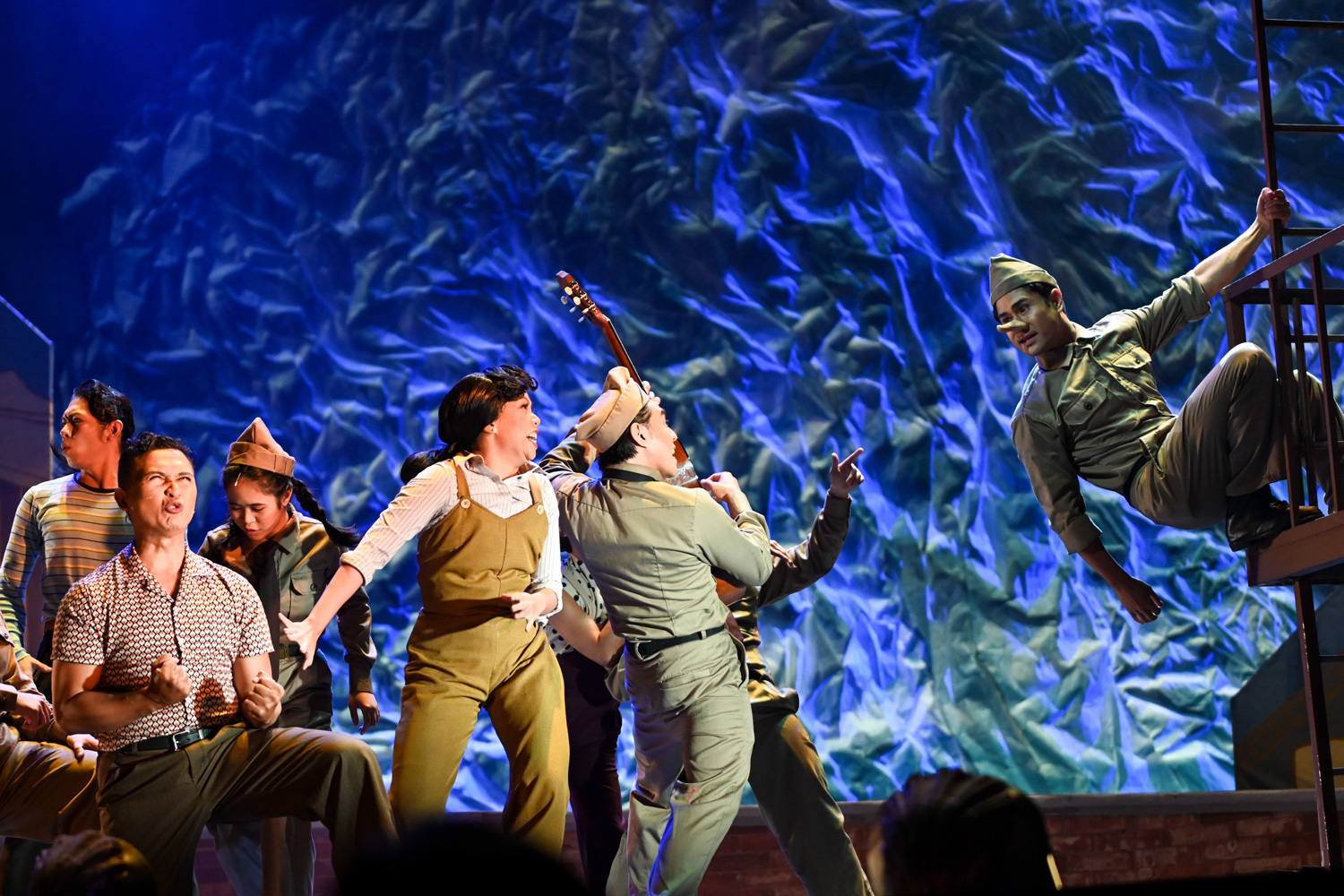
Photographed by Kyle Venturillo
Barefoot Theatre Collaborative brings a triumphant gem of a production that is an aural achievement as it is a visual masterpiece, with a narrative that is simple but uncompromising in what it wants to say, grand and otherworldly but deeply personal in speaking to its audience, making it powerful and effective in eliciting visceral responses and reactions in the form of euphoric laughter and tears, leaving a lasting impact of glee, agony, and hope to audiences even after departing the theater.
It goes without saying that be it for the unparalleled creative synergy of the cast, the music, and beautiful imageries, “Mula Sa Buwan” is a theatrical marvel that deserves, no, DEMANDS, to be seen, heard, and FELT on a live theater.
In all its grandiosity and surrounding fan-clamor, “Mula sa Buwan” goes beyond a celebration of the return of theater. It is a declaration and a reminder of the strength and power of the human spirit. It has created a space that allowed us to validate and even confront our many questions, our helplessness, and frustrations on what we see now as a rather turbulent, and unwelcoming time of divisiveness and history repeating itself.
And, even with a dark and tragic turn, it inspires you even just with the slightest tinge of hope and challenges your conviction to march forward and forge a path of change for a freer world.
Review updated on September 9, 2022
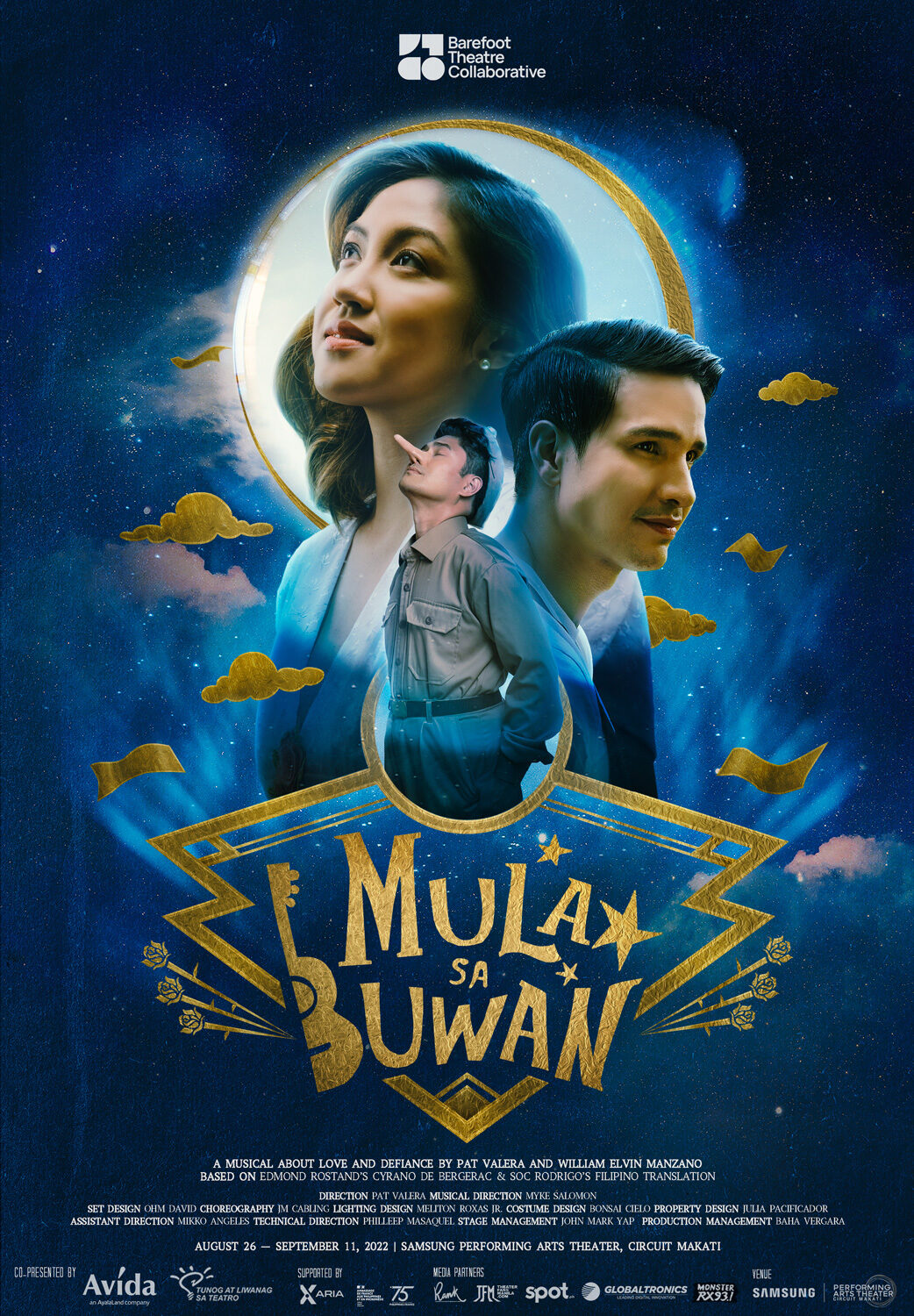
Rank Magazine is a premier media partner of Mula Sa Buwan 2022


